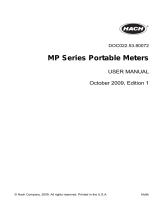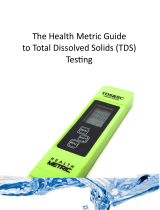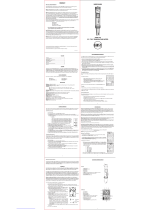Page is loading ...

PoolMeter
™
Model 512T5D
Operation Manual
05 July 09
Water Quality Instrumentation
A
ccuracy • Reliability • Simplicity
ACCURACY • RELIABILITY • SIMPLICITY

DESCRIPTION
This manual describes your Myron L 512T5D “Dual” Range
PoolMeter™, tells you how to use it, and tells you how to keep it
working accurately for many years.
Your PoolMeter is a compact instrument that operates on
the principal of electrical conductivity. It will quickly determine
the ppm/Total Dissolved Solids of almost any solution. The
PoolMeter converts electrical conductivity directly into parts
per million (ppm) of Total Dissolved Solids (TDS) AND ppm of
Minerals (Sodium Chloride/NaCl).
It is 85 x 129 x 126 mm/3.4 x 4.5 x 4.0 in. and weighs less
than 0,45 kg/1 lb. The PoolMeter is completely self-contained.
The built-in cell is automatically temperature compensated to
25°C/77°F when measuring within the range of 10° to 71°C/50°
to 160°F. It is powered by a 9 volt battery that lasts for at least
2000 tests (or one-year shelf life).
SCALE
512T5D 0-5000 ppm of TDS
0-5000 ppm of NaCl
By using an RE-10 Range Extender (see ACCESSORIES),
the maximum range may be increased ten times.
The pictures in this manual show the major operating parts
of your Myron L PoolMeter. Handle your instrument and identify
these parts to become familiar with it.
USING YOUR METER
1. Rinse the cell cup three times with the sample you wish to
test. (For very hot or very cold samples see TEMPERATURE
COMPENSATION.)
NEVER FILL THE CELL CUP BY DIPPING THE METER INTO
WATER!
2. Fill the cell cup with another sample to at least 1/4”/6.35 mm
above the upper electrode.
3. Select the desired range: T for TDS or N for NaCI.
S is the Internal Standard and is for fi eld calibration only. (See
bottom label for value.)
4. Press the black button.
5. Read the dial value indicated by the pointer to determine
parts per million (ppm), Total Dissolved Solids (TDS) or
Minerals.
6. If the pointer goes off the scale to the right, try Range
Doubling (see FIELD CALIBRATION) or an RE-10 Range
Extender (see ACCESSORIES).
NOTE:
When you are fi nished using the meter, RINSE THE CELL
CUP with clean water, preferably distilled or deionized.
TEMPERATURE COMPENSATION
For very hot or very cold solutions, let the three rinse
samples each remain in the cell cup for several seconds.
Then immediately fi ll the cell cup with the sample you want
to test (step 2 above). This allows the automatic temperature
compensation feature time to work properly.
CAUTION
DO NOT use with samples hotter than 71°C/160°F. The
readings WILL NOT be accurate.
DO NOT splash solvents such as lacquer thinner, acetone,
benzene or chlorinated solvents on the plastic case.
DO NOT fi x or modify the meter. This will void the warranty.
See SERVICE for details or consult the Myron L Company.
DO NOT DIP THE INSTRUMENT INTO WATER. If water
does get inside the instrument, see MAINTENANCE for
instructions on how to dry it properly.
CALIBRATION
STANDARD SOLUTIONS: A Standard Solution has a known
conductivity and ppm. Your meter was calibrated at the factory
using a Standard Solution. You can keep your meter accurate
by using the same Standard Solution. To pick the right Standard
Solution for your PoolMeter, see ACCESSORIES.
Selector Switch
S = Internal Standard; T = TDS; N = NaCl
1

CHECKING CALIBRATION
1. Test a sample of the appropriate Standard Solution.
CAUTION: Throw the Standard Solution away after using it. Do
not put the used samples back into the bottle.
2. If the PoolMeter does not indicate the same value as is on
the Standard Solution bottle’s label, fi rst clean the cell. For
directions on how to do this see CELL, pg. 3. Rinse the
cell thoroughly and test the Standard Solution again. If the
PoolMeter still does not indicate the correct value, recalibrate
as described below.
TO RECALIBRATE THE METER
1. Remove the bottom cover using your fi ngernails or a small
screwdriver to loosen the front or rear edge. Identify the
Calibration Control (see photo pg. 1) so you can fi nd it by
touch while calibrating.
2. Test another sample of the Standard Solution (be careful to
not get any solution inside the meter).
3. Adjust the Calibration Control until the meter indicates the
value that is on the Standard Solution label.
4. Select the “S” position.
5. Press the button. Compare the meter reading to the
INTERNAL STANDARD value on the meter’s bottom label. If
they are noticeably different, mark the new value in place of
the old one.
NOTE:
The PoolMeter may be calibrated to read either 442 or NaCI
parts per million. Calibrating one will automatically calibrate
the other.
INTERNAL STANDARD: An INTERNAL STANDARD value
for each meter is on the label on the bottom cover of each
meter. Use it as a reference between normal calibrations as
a fi eld check of your meter’s accuracy. To verify your meter’s
calibration:
1. Select the “S” position.
2. Press the button.
3. If the reading matches the INTERNAL STANDARD value on
the bottom label, your meter is in calibration. If not, see FIELD
CALIBRATION below.
NOTE:
The feature described above is intended as a quick fi eld
calibration check, or for the Range Doubling technique. It is
not a replacement for calibration with a Standard Solution.
FIELD CALIBRATION / MAINTENANCE
1. Remove the bottom cover using your fi ngernails or a small
screwdriver to loosen the front or rear edge.
2. Select the “S” position.
3. Press the button.
4. Adjust the Calibration Control until the meter reading is the
same as the INTERNAL STANDARD value on the bottom
label.
5. Replace the bottom cover.
RANGE DOUBLING
1. Remove the bottom cover.
2. Select the “S” position.
3. While pressing the button, adjust the Calibration Control until
the meter reads one-half the INTERNAL STANDARD value
shown on the bottom label. For example:
If the INTERNAL STANDARD value is 4200, adjust the
Calibration Control until the reading is at 2100.
4. Test your sample (take care to keep the inside of the meter
dry). Multiply the reading of the sample tested by two. For
example: If the meter reading is 3200, the actual value of the
sample tested is 6400 (3200 x 2).
NOTE:
After completing tests requiring Range Doubling, reset “S” to
its proper value and replace bottom cover.
MAINTENANCE
BATTERY CHECK
1. Select “S” position.
2. Press the button. Adjust the Calibration Control to maximum.
3. If the meter reads less than full scale, the battery should
be replaced. Remove the bottom cover. Detach the battery
connector. Pull on the vinyl strap to remove the battery.
Replace with a fresh 9 volt battery. Re-insert the vinyl strap to
secure battery.
2

CELL
Self-conditioning of the built-in electrodes occurs each time
the button is pressed with a sample in the cell cup. This ensures
consistent results each time. With some samples a small
downward swing of the pointer is a result of this conditioning
action. This action is powerful and removes normal fi lms of oil
and dirt. However, if very dirty samples—particularly scaling
types—are allowed to dry in the cell cup, a fi lm will build up. This
fi lm reduces accuracy. When there are visible fi lms of oil, dirt
or scale in the cell cup or on the electrode, scrub them lightly
with a small brush and household cleanser such as Comet™ or
Windex™. Rinse out the cleanser and the meter is now ready
for accurate measurements.
WATER INSIDE THE METER
Your Myron L PoolMeter is a rugged instrument and will
withstand water exposure around its cell, meter movement, and
switches. However, care should be taken to keep water from
leaking in around the bottom cover. It is not sealed in order to
prevent condensation from forming.
If water is relatively clean (i.e., tap water or better), and there
are only a few drops inside the meter, dry it as described below.
Large amounts of water, or corrosive or very dirty solutions will
almost certainly damage the meter movement or electronics.
Such meters should be returned to the Myron L Company for
repair.
TO DRY YOUR METER:
1. Shake excess water out of the inside of the meter.
2. Dab the exposed surfaces dry with an absorbent cloth or
tissue. Avoid getting any water into the Calibration Control or
either of the switches.
3. Air dry the meter in a warm area with the bottom cover off.
Allow several hours for thorough drying.
If the water entered through a leak in the case or cell, or if the
instrument shows erratic readings or other unusual behavior,
return it to the Myron L Company for service.
SERVICE
Any service required other than battery replacement, cleaning
or calibration must be referred to the Myron L Company.
Additionally, if you have any questions about this instrument,
its use, or a particular application, please contact the Myron L
Company directly (see back cover for contact information).
ACCESSORIES
STANDARD SOLUTIONS
442™: Unless otherwise specifi ed, your PoolMeter has been
factory calibrated with the TDS 442 Standard Solution. The
442 Standard Solutions consist of the following salt ratios: 40%
sodium sulfate, 40% sodium bicarbonate, and 20% sodium
chloride. This salt ratio has conductivity characteristics closely
matching natural waters and was developed by the Myron L
Company almost four decades ago.
Sodium Chloride: For every ppm 442 Standard Solution,
there is a ppm sodium chloride (NaCI) solution that will have
the same conductivity. The parts per million of the equivalent
NaCI solution is on each Standard Solution label. Instruments
calibrated to NaCI standards are set using equivalent NaCI
values.
All Myron L Company Standard Solutions are traceable to the
National Institute of Standards and Technology (NIST) and are
within 1.00% of reference solutions. The concentrations of the
reference solutions are calculated from data in the International
Critical Tables, Vol. 6.
All Myron L conductivity Standard Solution bottle labels
show three values: ppm 442, ppm sodium chloride, and
conductivity in micromhos.
RECOMMENDED STANDARD SOLUTIONS
SOLUTION TYPE ppm value 442™ ppm value NaCI
512T5D Calibration
442-3000 3000 2027
RE-10 Calibration
442-30,000 30,000/30 ppt 18,235/18.24 ppt
RANGE EXTENDER
Model RE-10
The RE-10 Range Extender is a useful accessory for testing
high conductivity/ppm solutions beyond the normal range of
your PoolMeter. Inserting the RE-10 into a sample-fi lled cell
cup increases the maximum range ten times. Use the Range
Extender whenever the reading is off the scale.
USING THE RE-10
1. To rinse, fi ll the cell cup three times while inserting the Range
Extender.
2. Fill the cell cup with your sample. Push the Range Extender
into the cell cup, seating the O-ring seal.
3. Use and read the PoolMeter in the normal manner. Multiply
the reading by 10.
4. For best accuracy, repeat the complete test with a fresh
sample.
5. When you’re fi nished testing, remove the Range Extender.
Thoroughly rinse the cell cup and Range Extender with clean
water (preferably distilled or deionized) to eliminate dried salt
build-up. This is extremely important when the instrument will
be used to test high purity water.
CALIBRATING THE RE-10
1. Calibrate the meter (without RE-10) using the appropriate
Standard Solution.
2. Fill the cell cup with the appropriate high conductivity
Standard Solution (442-30,000).
3. Insert RE-10 and press the black button. Multiply the
reading by 10 and compare it to the value on the Standard
Solution label. If they are not the same, the RE-10 must be
recalibrated.
NOTE: DO NOT adjust the Calibration Control.
4. Adjust the white insert of the Extender as follows: If the
reading is too high—push or tap inward.
If the reading is too low—twist or pull outward with pliers.
NOTE: Each Range Extender is factory calibrated to a particular
meter. It should be recalibrated if it is to be used with another
meter.
3

PORTA PAK
Carry Case for use with your
Myron L PoolMeter. It is foam-
lined and molded of sturdy ABS
plastic.
Model PTP
ORDERING
To order accessories contact your nearest stocking
distributor or the Myron L Company directly.
WARRANTY & SERVICE
The Myron L PoolMeter™ has a Two (2) Year Limited Warranty.
If your instrument fails to function properly, check the batteries
and calibration. If it still fails to function properly, return it
prepaid to the Myron L Company. If, in the opinion of the
factory, failure was due to materials or workmanship, repair or
replacement will be made without charge. A reasonable service
charge will be made for diagnosis or repairs due to normal
wear, abuse, or tampering. Faulty instruments may be returned
to us without prior permission.
This warranty is limited to repair or replacement of the
Myron L PoolMeter only. The Myron L Company assumes
no other responsibility or liability.
METERS WITHIN WARRANTY:
Failures due to materials or workmanship will be repaired
or replaced (our option) without charge if returned freight is
prepaid. If failure is deemed by the factory to have been caused
by abuse or tampering, the following procedure will apply:
METERS OUT OF WARRANTY:
Diagnosis will be made and repairs completed, providing the
repair charges are $70.00 or less.
NOTE: Actual repair charges may be less than this amount.
We will diagnose (but not repair) a returned meter and mail an
estimate of charges if ANY of the following apply:
1. Repair charges will be more than $70.00.
2. You specifi cally request an estimate of required repairs and
charges.
3. The cost of required repairs exceeds one-half the list price of
a new instrument.
4. The product is over 10 years old. Myron L takes pride in
attempting to repair instruments of any age (even as old
as 40 years). However, due to component availability and
product improvements, some older instruments may no
longer be repairable.
NOTE: Unrepaired meters are discarded unless you request
them returned to you. If so, there is currently a $35.00 charge
per unrepaired instrument to cover diagnosis and handling.
STANDARD SOLUTION
Standard calibration solution 442
TM
-3000
for use with your Myron L PoolMeter
TM
.
4

Water Quality Instrumentation
A
ccuracy • Reliability • Simplicity
ACCURACY • RELIABILITY • SIMPLICITY
MYRON L COMPANY
2450 Impala Drive
Carlsbad, CA 92008-7226 USA
Tel: +1-760-438-2021
Fax: +1-760-931-9189
E-Mail: [email protected]
www.myronl.com
Made in USA
512T5DOM 05JL09
/



